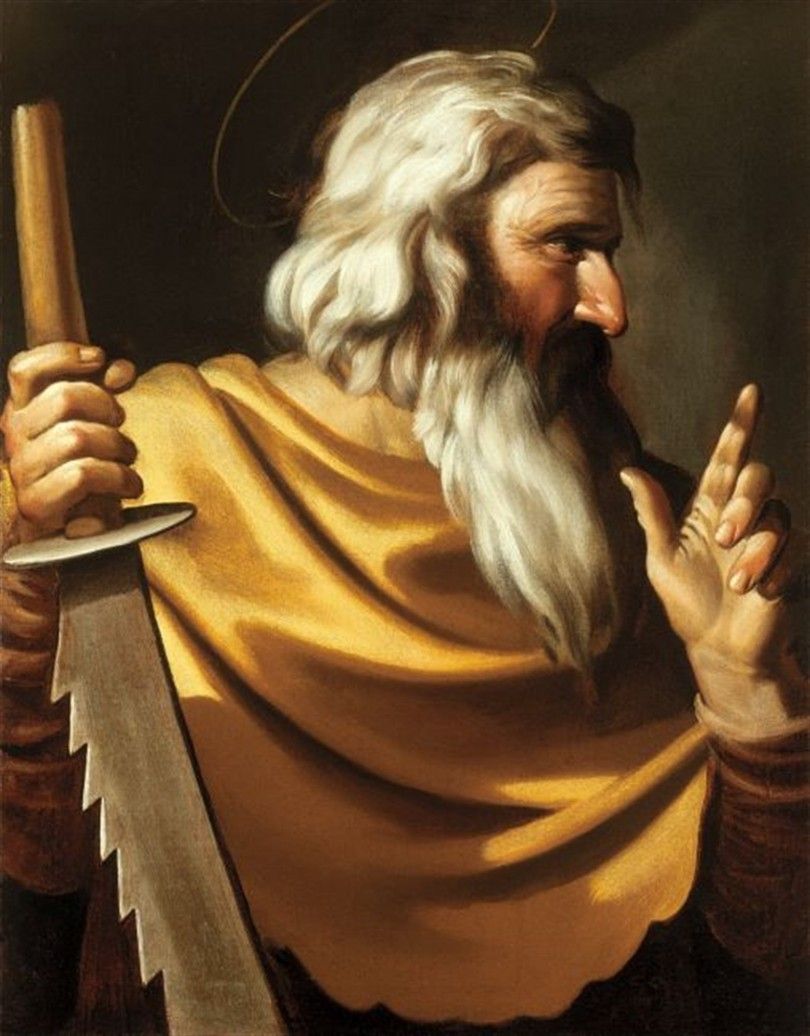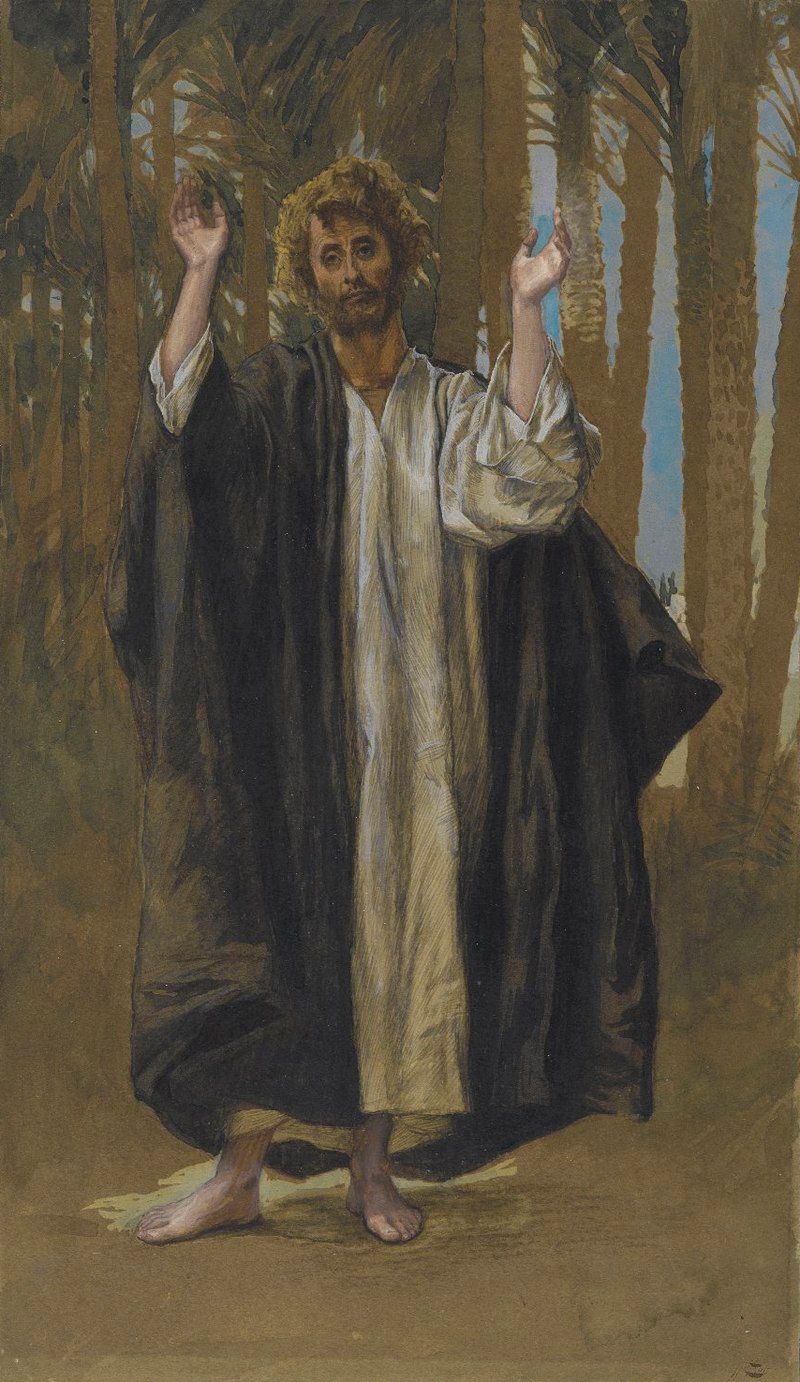The Catholic Encyclopedia suggests that Simon the Zealot may be the same person as Simeon of Jerusalem or Simon the brother of Jesus. He could perhaps be the cousin of Jesus or a son of Joseph from a previous marriage.
Another tradition holds that this is the Simeon of Jerusalem who became the second bishop of Jerusalem, although he was born in Galilee. Simon, like the other Apostles, is regarded as a saint by the Roman Catholic Church, the Eastern Orthodox Churches, the Oriental Orthodox Churches, the Eastern Catholic Churches, the Anglican Church and the Lutheran Church. In art, Simon has the identifying attribute of a saw because he was traditionally martyred by being sawn in half.∼Born Cana or Canaan
Died ~107 place of death disputed. Possibly Pella, Armenia; Suanir, Persia; Edessa
Venerated in Roman Catholic Church; Eastern Orthodox Church; Coptic Church; Oriental Orthodox Churches, Eastern Catholic Churches; Anglican Church; Lutheran Church.
Major shrine relics claimed by many places, including Toulouse; Saint Peter's Basilica
Feast October 28 (Roman Catholic Church); May 10 (Coptic Church)
Attributes boat; cross and saw; fish (or two fish); lance; man being sawn in two longitudinally; oar
Patronage curriers; sawyers; tanners
The apostle called Simon Zelotes, Simon the Zealot, in Luke 6:15 and Acts 1:13; and Simon Kananaios ("Simon" signifying שמעון "hearkening; listening", Standard Hebrew Šimʿon, Tiberian Hebrew Šimʿôn), was one of the most obscure among the apostles of Jesus. Little is recorded of him aside from his name: few pseudepigraphical writings were connected to him (but see below), and Jerome does not include him in De viris illustribus.
The name of Simon occurs in all the passages of the synoptic gospels and Acts that give a list of apostles, without further details.
Simon, whom he named Peter, and Andrew his brother, and James and John, and Philip, and Bartholomew, and Matthew, and Thomas, and James the son of Alphaeus, and Simon who was called the Zealot, and Judas ["the son" is interpolated] of James, and Judas Iscariot, who became a traitor. (Luke 6:12-16, RSV)
To distinguish him from Simon Peter, he is called Kananaios, or Kananites (Matthew 10:4; Mark 3:18), and in the list of apostles in Luke 6:15, repeated in Acts 1:13, Zelotes, the "Zealot". Both titles derive from the Hebrew word qana, meaning The Zealous, though Jerome and others mistook the word to signify the apostle was from the town of Cana (in which case his epithet would have been "Kanaios") or even from the region of Canaan. As such, the translation of the word as "the Cananite" or "the Canaanite" is purely traditional and without contemporary extra-canonic parallel.
Robert Eisenman has pointed out in James the Brother of Jesus : The Key to Unlocking the Secrets of Early Christianity and the Dead Sea Scrolls that contemporary talmudic references to Zealots as kanna'im "but not really as a group — rather as avenging priests in the Temple". (Eisenman's broader conclusions, that the zealot element in the original apostle group was disguised and overwritten to make it support the assimilative Pauline Christianity of the Gentiles is more controversial.)
In the canonic New Testament, Simon the Zealot is never identified with Simon the brother of Jesus mentioned in Gospel of Mark 6:3 :
"Isn't this the carpenter? Isn't this Mary's son and the brother of James, Joseph, Judas and Simon? Aren't his sisters here with us?"" —New International Version.
It is believed often that this is Simeon of Jerusalem, since he was born in Galilee.
In later tradition
St. Isidore of Seville drew together the accumulated anecdotes of St. Simon in De Vita et Morte; the fully-developed aura of legend is presented in the Legenda Aurea (ca 1260).
In later tradition, Simon is often associated with St. Jude as a proselytizing team; they share their feast day on 28 October. The most widespread tradition is that after evangelizing in Egypt, Simon joined Jude in Persia and Armenia, where both were martyred. This version is the one found in the Golden Legend.
Later traditions expand on an independent personality for Simon and speculate about his fate. One tradition states that he travelled in the Middle East and Africa. Christian Ethiopians claim that he was crucified in Samaria, while Justus Lipsius writes that he was sawn in half at Suanir, Persia. However, Moses of Chorene writes that he was martyred at Weriosphora in Caucasian Iberia. Tradition also claims he died peacefully at Edessa. Another tradition says he visited Britain -- possibly Glastonbury -- and was martyred in modern-day Lincolnshire. Another, doubtless inspired by his title "the Zealot", states that he was involved in a Jewish revolt against the Romans, which was brutally suppressed.
The 2nd century Epistle of the Apostles (Epistula Apostolorum) a polemic against gnostics, lists him among the apostles purported to be writing the letter (who include Thomas) as Judas Zelotes and certain Old Latin translations of the Gospel of Matthew substitute "Judas the Zealot" for Thaddeus/Lebbaeus in Matthew 10:3. To some readers, this suggests that he may be identical with the "Judas not Iscariot" mentioned in John 14:22: "Judas saith unto him, not Iscariot, Lord, how is it that thou wilt manifest thyself unto us, and not unto the world?" As it has been suggested that Jude is identical with the apostle Thomas (see Jude Thomas), an identification of "Simon Zelotes" with Thomas is also possible. The New Testament records nothing more of Simon, aside from this multitude of possible but unlikely pseudonyms.
In art, Simon has the identifying attribute of a saw because he was put to death by a saw.
See also the variant name Simeon.
In the rock opera Jesus Christ Superstar, Simon Zealotes sings to persuade Jesus to attack the Roman occupiers.
Sainthood
St. Simon, like the other Apostles, is regarded as a saint by the Roman Catholic Church, the Eastern Orthodox Churches, the Oriental Orthodox Churches, the Eastern Catholic Churches, the Anglican Church and the Lutheran Church.
The Catholic Encyclopedia suggests that Simon the Zealot may be the same person as Simeon of Jerusalem or Simon the brother of Jesus. He could perhaps be the cousin of Jesus or a son of Joseph from a previous marriage.
Another tradition holds that this is the Simeon of Jerusalem who became the second bishop of Jerusalem, although he was born in Galilee. Simon, like the other Apostles, is regarded as a saint by the Roman Catholic Church, the Eastern Orthodox Churches, the Oriental Orthodox Churches, the Eastern Catholic Churches, the Anglican Church and the Lutheran Church. In art, Simon has the identifying attribute of a saw because he was traditionally martyred by being sawn in half.∼Born Cana or Canaan
Died ~107 place of death disputed. Possibly Pella, Armenia; Suanir, Persia; Edessa
Venerated in Roman Catholic Church; Eastern Orthodox Church; Coptic Church; Oriental Orthodox Churches, Eastern Catholic Churches; Anglican Church; Lutheran Church.
Major shrine relics claimed by many places, including Toulouse; Saint Peter's Basilica
Feast October 28 (Roman Catholic Church); May 10 (Coptic Church)
Attributes boat; cross and saw; fish (or two fish); lance; man being sawn in two longitudinally; oar
Patronage curriers; sawyers; tanners
The apostle called Simon Zelotes, Simon the Zealot, in Luke 6:15 and Acts 1:13; and Simon Kananaios ("Simon" signifying שמעון "hearkening; listening", Standard Hebrew Šimʿon, Tiberian Hebrew Šimʿôn), was one of the most obscure among the apostles of Jesus. Little is recorded of him aside from his name: few pseudepigraphical writings were connected to him (but see below), and Jerome does not include him in De viris illustribus.
The name of Simon occurs in all the passages of the synoptic gospels and Acts that give a list of apostles, without further details.
Simon, whom he named Peter, and Andrew his brother, and James and John, and Philip, and Bartholomew, and Matthew, and Thomas, and James the son of Alphaeus, and Simon who was called the Zealot, and Judas ["the son" is interpolated] of James, and Judas Iscariot, who became a traitor. (Luke 6:12-16, RSV)
To distinguish him from Simon Peter, he is called Kananaios, or Kananites (Matthew 10:4; Mark 3:18), and in the list of apostles in Luke 6:15, repeated in Acts 1:13, Zelotes, the "Zealot". Both titles derive from the Hebrew word qana, meaning The Zealous, though Jerome and others mistook the word to signify the apostle was from the town of Cana (in which case his epithet would have been "Kanaios") or even from the region of Canaan. As such, the translation of the word as "the Cananite" or "the Canaanite" is purely traditional and without contemporary extra-canonic parallel.
Robert Eisenman has pointed out in James the Brother of Jesus : The Key to Unlocking the Secrets of Early Christianity and the Dead Sea Scrolls that contemporary talmudic references to Zealots as kanna'im "but not really as a group — rather as avenging priests in the Temple". (Eisenman's broader conclusions, that the zealot element in the original apostle group was disguised and overwritten to make it support the assimilative Pauline Christianity of the Gentiles is more controversial.)
In the canonic New Testament, Simon the Zealot is never identified with Simon the brother of Jesus mentioned in Gospel of Mark 6:3 :
"Isn't this the carpenter? Isn't this Mary's son and the brother of James, Joseph, Judas and Simon? Aren't his sisters here with us?"" —New International Version.
It is believed often that this is Simeon of Jerusalem, since he was born in Galilee.
In later tradition
St. Isidore of Seville drew together the accumulated anecdotes of St. Simon in De Vita et Morte; the fully-developed aura of legend is presented in the Legenda Aurea (ca 1260).
In later tradition, Simon is often associated with St. Jude as a proselytizing team; they share their feast day on 28 October. The most widespread tradition is that after evangelizing in Egypt, Simon joined Jude in Persia and Armenia, where both were martyred. This version is the one found in the Golden Legend.
Later traditions expand on an independent personality for Simon and speculate about his fate. One tradition states that he travelled in the Middle East and Africa. Christian Ethiopians claim that he was crucified in Samaria, while Justus Lipsius writes that he was sawn in half at Suanir, Persia. However, Moses of Chorene writes that he was martyred at Weriosphora in Caucasian Iberia. Tradition also claims he died peacefully at Edessa. Another tradition says he visited Britain -- possibly Glastonbury -- and was martyred in modern-day Lincolnshire. Another, doubtless inspired by his title "the Zealot", states that he was involved in a Jewish revolt against the Romans, which was brutally suppressed.
The 2nd century Epistle of the Apostles (Epistula Apostolorum) a polemic against gnostics, lists him among the apostles purported to be writing the letter (who include Thomas) as Judas Zelotes and certain Old Latin translations of the Gospel of Matthew substitute "Judas the Zealot" for Thaddeus/Lebbaeus in Matthew 10:3. To some readers, this suggests that he may be identical with the "Judas not Iscariot" mentioned in John 14:22: "Judas saith unto him, not Iscariot, Lord, how is it that thou wilt manifest thyself unto us, and not unto the world?" As it has been suggested that Jude is identical with the apostle Thomas (see Jude Thomas), an identification of "Simon Zelotes" with Thomas is also possible. The New Testament records nothing more of Simon, aside from this multitude of possible but unlikely pseudonyms.
In art, Simon has the identifying attribute of a saw because he was put to death by a saw.
See also the variant name Simeon.
In the rock opera Jesus Christ Superstar, Simon Zealotes sings to persuade Jesus to attack the Roman occupiers.
Sainthood
St. Simon, like the other Apostles, is regarded as a saint by the Roman Catholic Church, the Eastern Orthodox Churches, the Oriental Orthodox Churches, the Eastern Catholic Churches, the Anglican Church and the Lutheran Church.
Advertisement
Explore more
Sponsored by Ancestry
Advertisement







